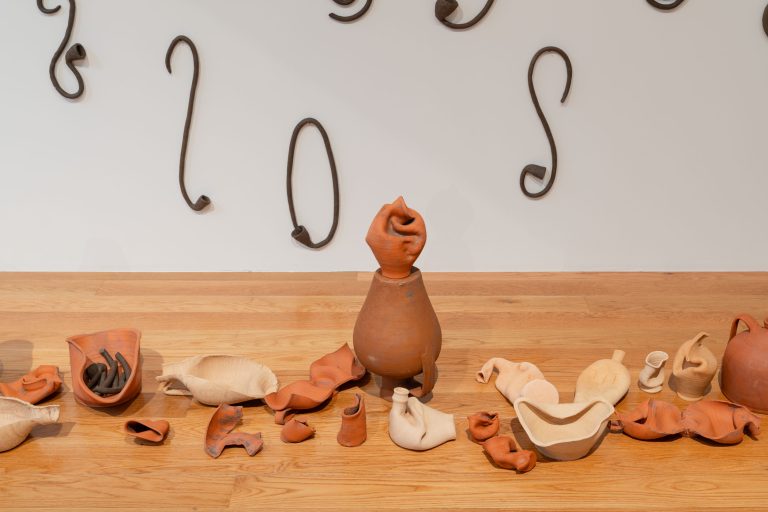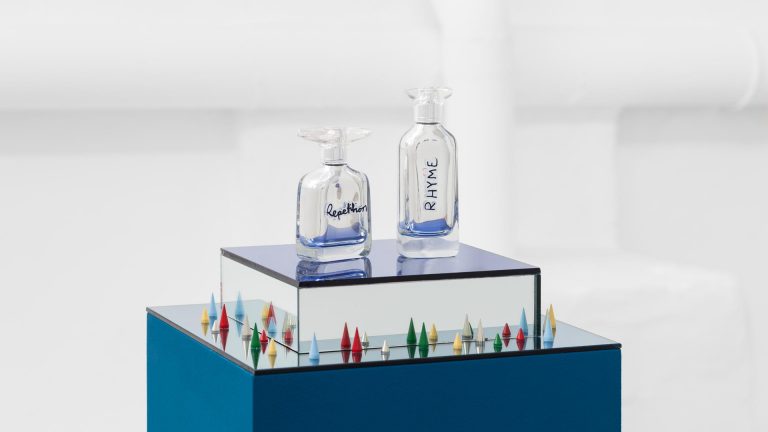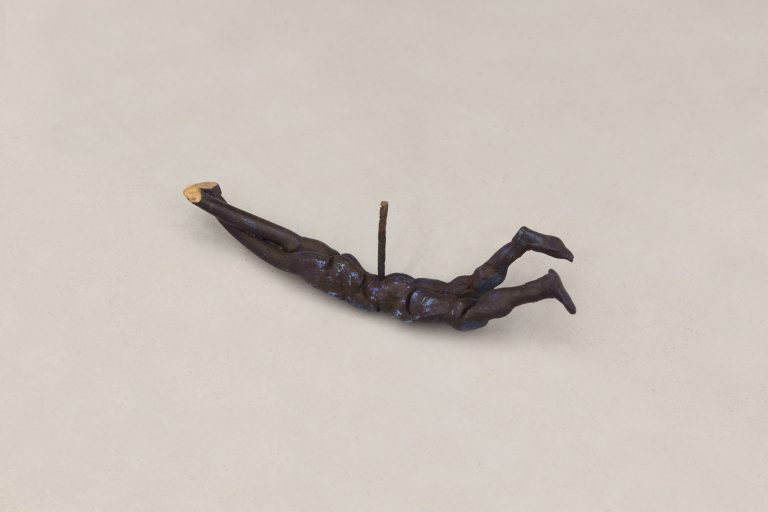Artist: Rodrigo Hernández
Exhibition title: Plasma
Venue: MADRAGOA, Lisbon, Portugal
Date: May 17 – September 9, 2017
Photography: all images copyright and courtesy of the artist and MADRAGOA, Lisbon
MADRAGOA is delighted to present Plasma, the first solo exhibition by Rodrigo Hernández at the gallery and in Portugal.
For his exhibition at Madragoa, Rodrigo Hernández presents one large floor installation that entirely occupies the space of the gallery. It consists of a number of thin metal sheets that had been modeled and embossed in order to let appear on their surface parts of a human figure caught in movement, froze in the simple action of walking up a step.
A recurring subject of Hernández’s practice, the human figure is also in this case devoid of distinctive traits, salient features, and adjectives that can characterize it: the work depicts a neutral person, the prototype of a man, a simple profile close to how a child would draw it. This silhouette is reminiscent of the living mannequins that inhabit the metaphysical paintings of Giorgio de Chirico and Carlo Carrà, but also the sculptural theatrical costumes of Fortunato Depero, while the metallic material with which it is shaped evokes a lucent armour, perhaps belonging to an incorporeal knight, or a nonexistent one, to borrow from Italo Calvino.
Each metal part is supported and kept in position on the floor by a modular structure made of coloured wood. The partition of the slab recalls the composition grid, a tool for visual space organization, commonly used to maintain the proportions and provide coherence to the whole composition when three-dimensional objects are transferred into bidimensional images or in the passage between two different scales. It also reminds a chessboard or a puzzle, since each piece is mobile: the entire installation has been conceived as a dynamic structure open to different configurations and combinations, a ductility also suggested by its horizontal format. Depending on the arrangement of the modular squares, the depicted subject will be consistent and legible, or it will be fragmented into an abstract mosaic of more or less recognizable elements.
In Hernández’s practice, the traditional vocabulary of art media and styles is reworked in a personal syncretism that blends together archaic taste and futurism. The representation of the moving body in the futuristic avant-garde consists in its fragmentation and re-composition, creating a synthesis that includes the effect that the environment exerts on it, conveying also the density of the space in a mutual deformation of body and space.
In Hernández’s installation the representation of the moving body gives way to the real action, to a spatial shift that actually disassembles the figure. Between figuration and abstraction, the silhouette on the metal surface is also halfway between a two-dimensional pictorial representation, with its shadows and light areas, and an all-round sculpture, close to a bas-relief, but lying supine. The title of the installation, Plasma, with its various meanings and etymological complexity, reflects the implications inherent in the work. From the Greek word plasma: “creature”, “something molded or created”, which comes from the verb plassein: “to mold or form”, with an Indo-European root meaning “to spread thin”. If in Modern Greek plasma is still used referring to a creature, but only imaginary, in the particular Cypriot dialect it is still commonly employed also to indicate a “person”, in a generic sense. In Greece, however, atom is the word taking this same role; a person, as an atom is essentially individual; that is, structurally indivisible.
The most common meaning today of blood and ion plasma is recent and passes through English, in which plasma originally meant a “pot”, derived from its ancient definition as “anything shaped or molded”, that led to the other meaning of “vessel” or “vehicle”. That is why plasma has been used to define the liquid component that holds the blood cells in suspension, the substance that the blood cells float in. From being the creature, the thing shaped, it became a shapeless element, an active, invisible component, an element in between that holds united atoms and particles, designating also the fourth state of matter, the obscure energy of which stars are made of.
A visual correspondent of the ineffable plasma could be found in René Magritte’s illustrations, in which small clouds, stains, speech bubbles and shapeless forms are often inserted without a precise function. According to Hernández’s intuition, these shapes could take on the role of plasma, in the sense of a “vector” of meanings, the materialization of the void that separates and combines the word and the thing, the word and the image. Plasma matter is thus embodied in a vital, malleable form, which seems ready to be shaped depending on the context in which it is used or the word to which it is associated, not far from the logic of Japanese logograms or Kanjis.
In the same way, Hernández’s work is open and malleable, and expresses a passage, a transformation both material and related to the word “plasma”: the creature, the person molded into the thin metal surface becomes abstract when scattered, without ever dispersing. During the months of the exhibition, the composition will be periodically reshaped according to different combinations and thus the figure will remain both static and in permanent motion.
On Friday, May 19th, Rodrigo Hernandez’s new book I am Nothing, published by the Heidelberger Kunstverein with Bom Dia Boa Tarde Boa Noite (Berlin), will be launched at Madragoa, from 10am to 1pm.
Rodrigo Hernández (Mexico City, Mexico, 1983) lives and works between Lisbon and Mexico City. He studied at the Akademie der bildenden Künste in Karlsruhe with Silvia Bächli in 2010-2012, and at Jan Van Eyck Academie in Maastricht in 2013-2014. In the last years he has been awarded with a residency at Laurenz-Haus Stiftung in Basel in 2015 and at Cité International des Arts in Paris in 2016. His recent solo exhibitions include: The Shakiest of Things, Kim?, Riga, 2017; I am nothing, Heidelberger Kunstverein, Heidelberg, 2016; Every forest madly in love with the moon has a highway crossing it from one side to the other, Kurimanzutto, Mexico City, 2016; El pequeño centro, Museo Universitario del Chopo, Mexico City, 2015; What is the moon?, Bonnefantenmuseum, Maastricht, 2015; Go, gentle scorpio, Parallel Oaxaca, Oaxaca, 2014; A Sense of Possibility, Weingrüll, Karlsruhe, 2014. His recent group exhibitions include: Illusion and Revelation. From the collection of the Bonnefantenmuseum, Bonnefantenmuseum, Maastricht, 2016-2017; Neither, MendesWoodDM, Brussels, 2017; An ear, severed, listens, ChertLüdde, Berlin; 12th Bienal Femsa Monterrey, Monterrey, 2016-2017; Hyperconected – 5th Moscow Bienal for Young Art, Moscow Museum of Modern Art, Moscow, 2016; Um die Ecke denken, Museum Haus Konstruktiv, Zürich, 2016; Marriage, Queer Thoughts, New York, 2016; Jungs, hier kommt der Masterplan, Kunsthalle Basel, Basel, 2016.






















